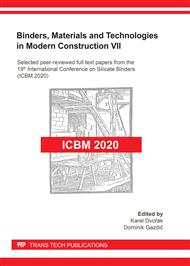p.86
p.92
p.98
p.104
p.113
p.119
p.125
p.131
p.137
Design of High-Strength Concrete for Ready-Mixed Concrete Production
Abstract:
The high-strength concrete is a cement composite reaching high compressive strength, namely, pursuant to the legislation, higher than 60 MPa in the terms of cube compressive strength. The development of high-strength concretes exceeding 100 MPa is still an up-to-date issue and the production of these concretes is still limited only to a prefabrication. Contemporary construction industry and projecting activity have begun to focus on a construction of statically demanding buildings, which can include e.g. high-rise buildings. Such projecting often requires using of the state-of-the-art materials like cement composites with high mechanical parameters for construction of more subtle buildings. Within this article, the procedure of ready-mixed concretes development with the compressive strength around 100 MPa designed according to a project documentation for actual construction of high-rise building with the height up to 160 meters and 46 floors is described, together with the influence of the aggregate on the resulting composite strength.
Info:
Periodical:
Pages:
113-118
Citation:
Online since:
October 2021
Authors:
Price:
Сopyright:
© 2021 Trans Tech Publications Ltd. All Rights Reserved
Share:
Citation:


